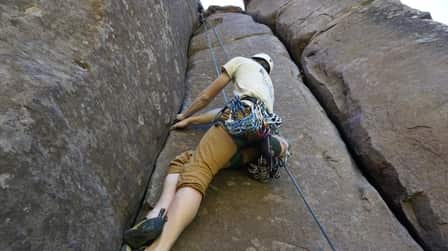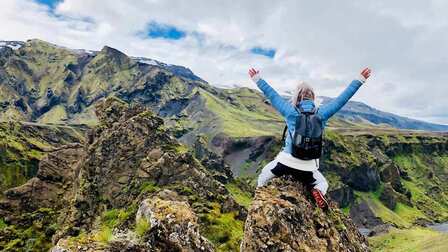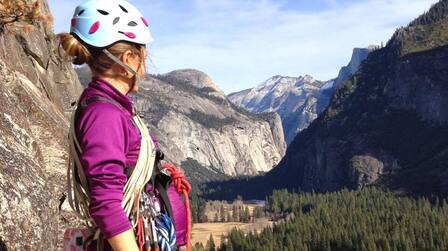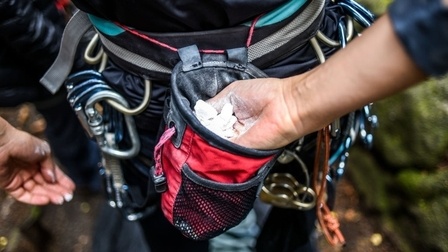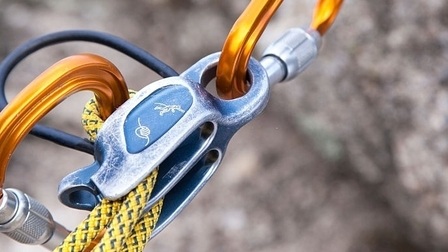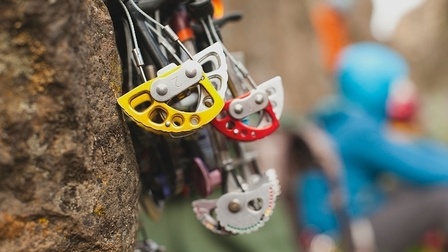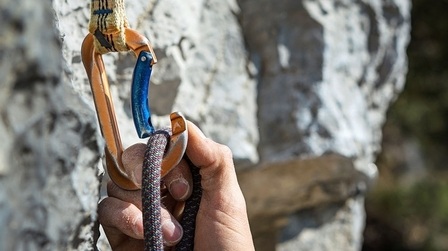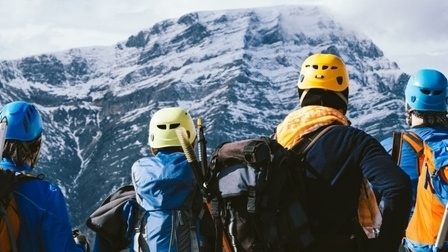Climbing is a great sport. Participating in mountain climbing brings you a lot of benefits, the best benefit is health. Climbing helps you stay healthy, relax after tiring days, and socialize with friends.
Taking part in mountain climbing regularly helps you to find new climbing techniques, to perfect and correct your bad habits. Climbing is a sport of skill. It relies heavily on muscle memory. This muscle memory can work for or against you because bad habits are so hard to break.
To equip climbing skills, to climb mountains better, we provide some tips to increase your climbing technique, which we hope can be of great help to those involved in this extreme sport.
1. Technique of the feet
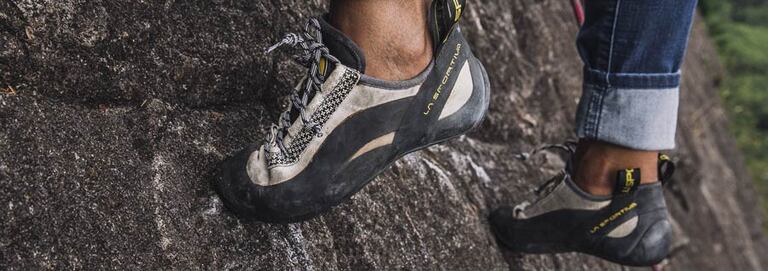
The technique of the feet is very important to the climbing process. However, it is often overlooked when you start climbing because the focus tends to be on your upper body strength, but the feet are the best place to put your weight, Helps relieve stress on your forearms and puts your body in a more efficient position to achieve your next position and goals.
To increase your climbing performance, try using small, frequent foot movements. Try working with a 3:1 ratio, which means you do three leg movements for each arm move. Climbing this style will train you to keep your body against the wall and your weight on your legs.
2. Invest in yourself a good pair of shoes

If you're new to the sport, and envision it popping into your life, it's well worth taking the time to buy the right pair of shoes. The precision and quality of high-end shoes will allow you to use all parts of your foot and you will reap significant benefits from this right from the start.
When you first join, you can rent shoes for your first trips to the climbing gym and try on different styles and sizes if they are available. When you go to buy a pair of your own shoes, make sure you try to stand on one foot, putting all your weight on different parts of each foot. Their fit should be snug but not uncomfortable or tight.
3. Bring your body close to the wall

Keeping your body close to the wall is an important way to conserve energy during climbing. Moreover, it will help you prepare for the next moves. If you let your body fall off the wall, it lowers your center of gravity, puts more weight on your arms, and makes the upward movement much more difficult. It may seem like a lot of effort at first, but as muscle memory kicks in, it becomes a habit.
It is important to take care to avoid climbing up the wall like a ladder with both hips and stomach against the wall, as this will put heavier and unnecessary weight through the arms.
Keep an eye on your knees! If they're facing the wall, chances are there's too much space between your body and the wall. So if you find yourself grazing your knee after every climb, practice turning your knees inward or outward to pull your body closer to the wall.
4. Step back

Set yourself an easy route and challenge yourself to use this method for every move. You will only have the outer hip crooked towards the wall. You'll start learning when and when not to use step back. It will become a subconscious addition to your climbing move soon.
A backward step is when you're standing on a stand, with the outside of your foot closest to the wall instead of the inside of your foot. The outside of your hips on the same leg will also be next to the wall and you won't be as jittery as when climbing a ladder. Your other foot may become redundant, but it can be put to good use by placing it on a wall for balance or as a lever so you can rotate your body into this new position.
This technique helps to save precious energy and also gives a further goal. Practice and experiment, your climbing will become more fluent with less effort. Your upper body will thank you for it!
5. Try to breathe steadily

A steady flow of oxygen to the muscles is important for energy production and recovery, and slow, deep, and steady abdominal breathing is the best way to get the job done. In fact, many climbers tend to turn to shallow and fast breathing when fatigued. Worse still, some climbers unintentionally hold their breath during times of high stress. These are two trends that you must watch out for and actively deal with if you want to climb as high as you can.
Before starting the climb, pause to close your eyes and breathe deeply and slowly. Feel your belly expand outward as you slowly inhale, then allow the air to escape gently through pursed lips for ten slow seconds (count in your mind).
As you begin to climb, try to maintain a slow and steady breathing like you started on the ground. Use every rest position as an opportunity to reset your breathing cycle with a few deep, slow belly breaths. Such active breath control is like filling up your gas tank.
6. Consistency

Practicing climbing regularly, several times a week, maybe just for short sessions, can also help improve your muscle memory and body awareness. Many climbers get used to having to climb for several weeks, or aren't suitable for training, and as a result their progress has disappeared. After some time coming back, they will either feel depressed or their goal level drops. To prevent this, try to maintain your climbing! This is the best way to improve your technique, especially in the beginning (first few years in the sport), as consistency is key to your muscle memory development.
7. Always set goals, make efforts, challenge yourself

If you persist with the same difficulty level of the climb, you will have limited progress on this level. It is understood that you should climb routes that challenge you and that you need 100% effort. Your body will adapt to any obstacle you give it, so fear not. If you have a tough challenge, you should tap everything in twice or less, i.e. you're not trying hard enough to stimulate progress.
Set yourself a goal project, it is something, a driving force that inspires you. Climbing is a great sport to combine your strengths and weaknesses. Don't expect to do all the steps the first time you climb the mountain. Keep reminding yourself that if you're trying, whether you're trying or not, you're making progress!
8. Always looking for a way that makes a positive change

When you achieve your goal, set a goal higher than it and try to conquer it. This creates the perfect opportunity to gain strength and learn new techniques. Did you complete all the routes at your red point limit? Try to reach the goal to have new angles, new experiences. For example, if you mostly climb indoors, go outside for a few weeks and vice versa. Importantly for this sport, initial strength is essential for climbing.
Alternatively, just switch the climbing area and rock type. The different types of kicks offer unique footwork, sequence, and positioning challenges. This variety of variation increases strength and technique, allowing you to try out new movements in a variety of ways.
9. Patient

Goals cannot be achieved overnight, especially with this sport. Climbing requires equal strength and skill. With no pauses, careful and effective movement can take years of practice to develop.
Building your strength in the sport will only get you far if you don't develop the mental and logistical aspects. Forge the patience to practice your climbing technique for a long time, learning to accept failure as part of the process.
10. Improve your climbing ability by "climbing only!"

Don't spend hours on strength training. Make it valuable, but you don't have to be strong to be good. It will certainly help when you start pushing points but you will gain a lot more by practicing good technique and just climbing.
The first and most obvious thing you need to do is just climb up. Climb as much as possible. Climb up with your friends and observe how they solve problems. Listen to their advice and learn from their mistakes and share their victories.
11. Diversify the climbing process

Coaching something we are already good at and mastered is a habit too easy to get into. Why would you want to do something you're not good at when there are alternatives and more fun? Mountain climbing is no exception.
We all have climbing styles that we love and work towards. Climbing is suitable for each person's height or physical field.
It is only when we are pushed into challenges and difficult situations that we realize that we have deepened ourselves into being good at only one thing.
Be diverse and challenge yourself to conquer different peaks. Try a different type of climbing or climb in alternate locations. And look for different rocks. The more you become a professional climber, the better equipped you will be to weather whatever comes your way. You'll also get to discover some great places.
Conclusion
Mountain climbing is a sport that brings a lot of benefits, both in terms of health and spirit, helping to increase patience and skill training. However, if you are not well equipped with climbing technical knowledge, you will be easily discouraged and give up, possibly even causing injuries during climbing. Hopefully these tips to increase your climbing technique will help you.


